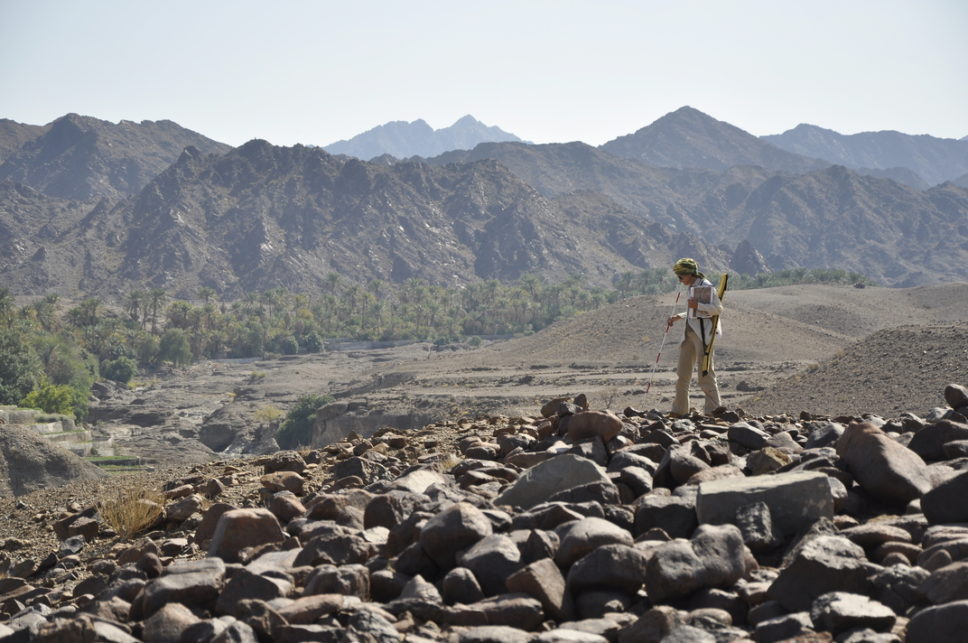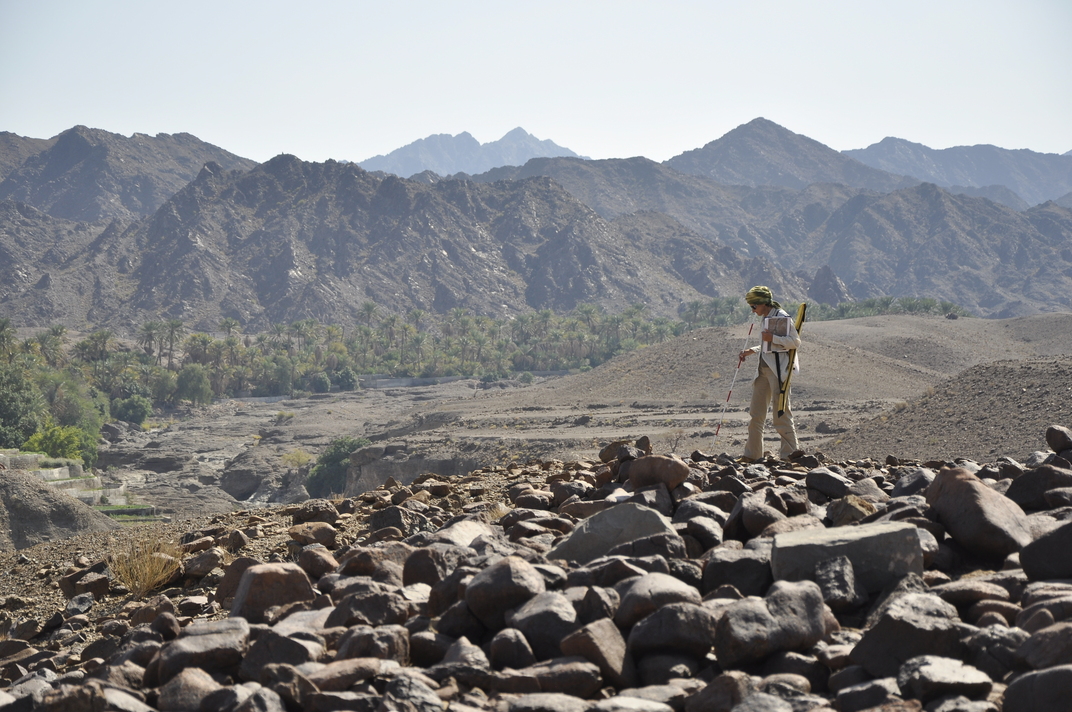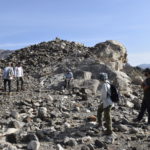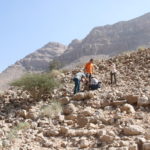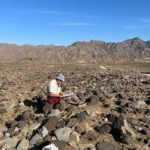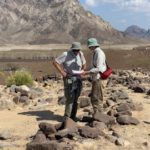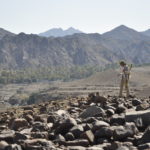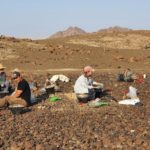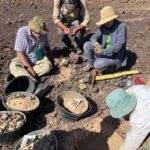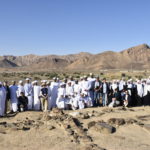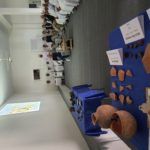In late December, an expedition of the Polish Centre of Mediterranean Archaeology of the University of Warsaw (PCMA UW) returned to Poland, having conducted archaeological research in northern Oman. The focus of the season was the search for traces of ancient metallurgy and remnants of Bronze and Iron Age settlements in the Hajar Mountains.
The research focused around the so-called Qumayrah micro-region, where the expedition headed by Prof. Piotr Bieliński (PCMA UW), has been working as the first Polish archaeological team in the country since 2016. To date, it has recorded dozens of previously unknown archaeological sites of various chronologies, from the Neolithic period to pre-modern times. Excavations have taken place at several of these sites bringing, among other results, the discovery of a four-thousand-year-old game board (link).
This year, the expedition carried out the final season of field documentation as part of the project “Development of Bronze and Iron Age Settlement in the Mountains of Northern Oman” under the direction of Prof. Bieliński, while another part of the team, under the direction of Dr. Agnieszka Pieńkowska (PCMA UW), worked on the project “The role of copper mining in shaping Bronze Age settlements in northern Oman. Archaeological and geological research in the mountain region of Qumayrah”.
During five weeks of work, an archaeological and geological field survey and test excavations were carried out at 10 sites (QA 3, QA 20, QA 21, QB 6, Muraybi, Ajran 1-4, Salh). More than 50 structures from different periods of the Bronze Age (Umm an-Nar and Wadi Suq cultures) and several Iron Age structures were documented along with dozens of features from later periods or of undetermined chronology.
Among the oldest, dated to the Early Bronze Age, or the so-called Umm an-Nar period (c. 2600–2000 BCE), were round stone towers typical of this culture (e.g., at the sites of Ajran 1 and QB 6) and tower tombs (Ajran 4). – “In general, traces of settlement from the Umm an-Nar period seem to be most prevalent in the study area. This shows that even a region located in a mountainous hinterland valley could have participated in the economic and demographic boom that occurred during this period, ” says Prof. Piotr Bieliński, head of the expedition.
Economic development during the Umm an-Nar period was largely driven by far-reaching overseas trade, with India and Mesopotamia, the main export commodity of which was Omani copper. Therefore, identifying traces of metallurgy in the surroundings of the Qumayrah micro-region was the goal of the second project undertaken this year. In this task, the archaeological team was assisted by geologists from the AGH University of Krakow, the Polish Geological Institute and the Faculty of Geology, University of Warsaw.
The sites that yielded the richest finds related to metal smelting are concentrated around Wadi Salh, where a new complex of sites has been documented. – “There are slag fields measuring about 220 x 50 m, and 25 to 40 cm thick. On ground surface, we found dozens of stone tools used for crushing ore and numerous fragments of furnace walls used for smelting copper. Remains of buildings that most likely served as workshops have also been preserved,” – says Dr. Agnieszka Pieńkowska. – “They must be the remnants of long-term activities related to the processing of copper ore. However, the question of their chronology can only be resolved once the dating materials have been analyzed,” – explains the archaeologist.
Iron Age (c. 1300–300 BCE) remains appear to be much less common. The most impressive of these were found at site QA 20. – “This is a settlement, probably featuring an observation or defense tower, located on a hill overlooking the intersection of two valleys, which could have been used by caravans travelling from the large oases in the southern Hajar mountains to the coast of the Gulf of Oman on the one hand, and to centers located in the territory of today’s UAE on the other,” says Prof. Bieliński. To the archaeologists’ surprise, the buildings of this Iron Age II settlement (c. 1100–600 BCE) are densely and regularly spaced. In the excavated part of the site, 33 rooms belonging to adjoining houses arranged on both sides of a narrow street were uncovered on an area of about 1400m2. – “This kind of plan is far removed from the rural character of the settlements one would expect in such a small mountain center,” – says the archaeologist.
As every year, the results of the latest research of the Omani-Polish archaeological expedition were of interest to local residents. School children from the village of Qumayrah visited the sites, and the sheikh of the village invited Prof. Bieliński to give a short presentation to the students and teachers. On this occasion, both archaeologists and geologists presented their actual finds, explaining their age and significance. The local people often find similar objects, so they listened with curiosity to the scientific information about these artefacts and geological specimens.
- The Omani-Polish Archaeological Mission is a cooperation between the Ministry of Heritage and Tourism of the Sultanate of Oman and the PCMA. Read more abouth the work of the Omani-Polish Archeological Mission
- The project “The development of settlement in the mountains of northern Oman in the Bronze and Iron Ages” is financed with a grant from the Polish National Science Centre (2018/30/M/HS3/00635). Read more
- The project “The role of copper mining in shaping Bronze Age settlements in northern Oman. Archaeological and geological research in the mountain region of Qumayrah” is financed with a grant from the UIniversity of Warsaw “Excellence Initiative – Research University” Program, POB IV: New Ideas 3B; grant no. BOB 622-321/2023. Read more
Press Release: PDF.
-
Fig. 1 Reconnaissance at site QB 6, where the remains of a round tower building made of white limestone were found (photo: PCMA UW/ Agnieszka Szymczak). Rekonesans na stanowisku QB 6, gdzie znaleziono pozostałości okrągłej budowli wieżowej z białego wapienia (Fot. CAŚ UW/ Agnieszka Szymczak).
-
Fig. 2 The rocky slopes of the mountain hide the remains of numerous buildings and ancient pottery (photo: PCMA UW/ Olga Puszkarewicz). Na kamienistych stokach górskich kryją się pozostałości licznych budowli i starożytnej ceramiki (Fot. CAŚ UW/ Olga Puszkarewicz).
-
Fig. 3 Prof. Piotr Bieliński during documentary fieldwork (photo: PCMA UW/ Dorota Bielińska). Prof. Piotr Bieliński podczas dokumentacyjnych prac terenowych (Fot. CAŚ UW/ Dorota Bielińska).
-
Fig. 4 Prof. Piotr Bieliński and Dr. Agnieszka Pieńkowska (photo: PCMA UW/ Jakub Śliwa). Prof. Piotr Bieliński i dr Agnieszka Pieńkowska (Fot. CAŚ UW/ Jakub Śliwa).
-
Fig. 5 Topographer at work (PCMA UW/ Agnieszka Szymczak). Topograf przy pracy (Fot. CAŚ UW/ Agnieszka Szymczak).
-
Fig. 6 Documentation of Bronze Age remains near Wadi Qumayrah (photo: PCMA UW/ Agnieszka Szymczak). Dokumentacja pozostałości z okresu brązu w okolicy Wadi Qumayrah (Fot. CAŚ UW/ Agnieszka Szymczak).
-
Fig. 7 A slag field in Wadi Salh; flags mark stone tools for crushing ore (photo: PCMA UW/ Agnieszka Szymczak). Pole szlaki w Wadi Salh; chorągiewkami zaznaczone są narzędzia kamienne do rozkruszania rudy (Fot. CAŚ UW/ Agnieszka Szymczak).
-
Fig. 8 Geological survey work at the metallurgical site in Wadi Salh (photo: PCMA UW/ Agnieszka Szymczak). Prace przy sondażu geologicznym na stanowisku metalurgicznym w Wadi Salh (Fot. CAŚ UW/ Agnieszka Szymczak).
-
Fig. 9 Geological team at work at the metallurgical site in Wadi Salh (photo: PCMA UW/ Agnieszka Szymczak). Zespół geologów na stanowisku metalurgicznym w Wadi Salh (Fot. CAŚ UW/ Agnieszka Szymczak).
-
Fig. 10 Meeting with representatives of the local community and schoolchildren from the village of Qumayrah (photo: PCMA UW/ Agnieszka Pieńkowska). Spotkanie z przedstawicielami lokalnej społeczności i uczniami ze szkół we wsi Qumayrah (fot. CAŚ UW/ Agnieszka Pieńkowska).
-
Fig. 11 Representatives of the local community, teachers and students from schools in the village of Qumayrah with members of the Omani-Polish expedition at the QA 20 site (photo: PCMA UW/ Olga Puszkarewicz). Przedstawiciele lokalnej społeczności, nauczyciele i uczniowie ze szkół we wsi Qumayrah oraz członkowie omańsko-polskiej ekspedycji na stanowisku QA 20 (Fot. CAŚ UW/ Olga Puszkarewicz).
-
Fig. 12 Prof. Bieliński’s lecture on the results of research in the Qumayrah micro-region for students of local schools (photo: PCMA UW/ Agnieszka Szymczak). Wykład prof. Piotra Bielińskiego na temat rezultatów badań w mikroregionie Qumayrah dla uczniów miejscowych szkół (Fot. CAŚ UW/ Agnieszka Szymczak).

